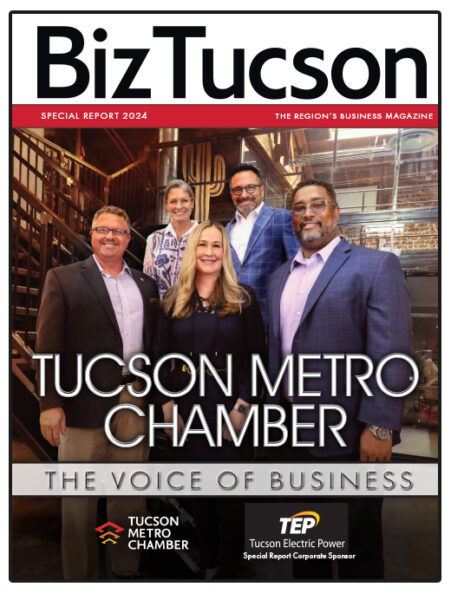
Q&A with Board Chair Linda Welter
Q.What are the major local challenges the Tucson Metropolitan Chamber of Commerce is working on that businesses in the region currently face to remain competitive?
A. Access to Talent. The No. 1 challenge that businesses of all sizes experience is finding qualified individuals to fill their job openings. The Chamber facilitates conversations between business, government, education, and community leaders to address workforce barriers including training, education, access to quality childcare, affordable housing and transportation. Addressing these issues will connect qualified job seekers to local employers, which our community needs.
Affordable Housing. The rising costs of homes in Tucson have become a challenge for job seekers and employers. The Chamber works closely with policymakers to advocate for responsible land use within our community. By identifying solutions to streamline the entitlement processes and ease the regulatory burden on subsequent development, the Chamber plays a key role along with other community partners such as the Southern Arizona Homebuilders Association, Metropolitan Pima Alliance, and the Tucson Association of Realtors in shaping policies that enable more affordable homes in our community.
Public Safety. The rising number of people using illegal substances, vandalizing business property and committing retail theft has caused some local small businesses to close and eliminate jobs. Other businesses are relocating to safer communities. Those that stay are passing along increased security costs to their customers through higher-priced goods and services. The Chamber is leading discussions with local law enforcement, policymakers and prosecutorial offices to find solutions to this growing public safety problem.
Transportation. The Chamber is working with Pima Association of Governments staff and regional representatives on the Regional Transportation Authority board to advocate for a more accessible transportation system throughout the region that links employees to jobs and customers to local businesses.
Q. How is the Chamber collaborating with other organizations to support local business expansion and job creation?
A. The Chamber works closely with Sun Corridor, Southern Arizona Leadership Council, Chamber Alliance of Southern Arizona, and other organizations that excel in addressing statewide issues that impact local businesses. Those partnerships are crucial when working with the City of Tucson and Pima County to advance policies that bolster our region’s business competitiveness. Site selectors and company executives state that regional partners who solve problems collaboratively are the areas that achieve the greatest business growth and expansion.
Q. How is the Chamber different today than it was five years ago?
A. The Chamber’s primary focus today is on solving local business issues within the city and county. Our partners, including SALC and Greater Phoenix Chamber, are effectively addressing state regulations impacting Arizona businesses. Rather than duplicate efforts at the state level, the Chamber realigned its staff, strategic plan and resources to achieve greater impact locally. The primary local policies and initiatives the Chamber’s business advocacy team is engaged with in 2024 include RTA Next, prevailing wage ordinances, Plan Tucson, Pima Prospers and others to ensure the business community is an active participant in these important conversations that impact growth.
Q. Why should businesses join and get involved with the Chamber?
A. We’ve been working very hard to collaborate with not only business, but also nonprofit organizations and the community at all levels. Our aim is to be a connector and a collaborator. Along those lines, a goal of mine this year is to meet all the local elected officials. While we may not always agree politically, we can work collaboratively to advance our shared interests. We’re fostering relationships that perhaps were broken down before.
Q. What do you plan to accomplish in your role as Board Chair?
A. My ultimate goal is to create a pro-business community where businesses can grow and succeed in our region. When businesses are successful here, they are creating jobs, paying taxes, donating to causes, and contributing to the prosperity of our region. I see the direct connection very clearly, and moving the needle through the Chamber’s work is a goal I am passionate about. The Chamber has a diverse, experienced, talented board and staff capable of accomplishing this goal. However, the Chamber still has work to do, including narrowing its strategic focus and realigning resources to increase its impact, strengthening and expanding its relationships and partnerships, increasing its membership base, building its PAC, and elevating its reputation as a diverse, effective organization through outcomes. The Chamber board, staff and I are making progress, and I am encouraged about the possibilities that we can achieve together.
Q. What does leadership look like to you? How does the Chamber lead?
A. Leaders have a vision. They surround themselves with smart people, many of whom think differently than themselves. Leaders are willing to make tough decisions, even if it will subject them to criticism, because the tough decision is the right decision. Leaders also listen to their team and pivot when needed. That’s what the Chamber has done and will continue to do. We’re helping people and making a difference. Take the COVID-19 pandemic. The Chamber is connecting people to resources, while working remotely. I’m proud to be part of an organization that selflessly helps others.
Pictured above – Linda Welter, Board Chair Tucson Metro Chamber, Founder & CEO, Caliber Group. Photo by Brent G. Mathis






